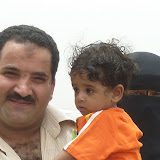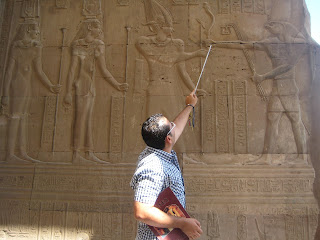We have been reveling in the wonders of Egypt for the past 17 days. Tomorrow, early we head up the East side of the Sinai peninsula, cross into Israel and try to figure out how to get to the Jordan border. From there a plunge into the Bedouin desert. Our camel awaits. More about that later.
Our Egypt VolkVenture Vlog has been easy and difficult to do. There is so much to say and way too many pictures so it will be submitted in parts. First will be Christina's incredible perspective and then a couple of things from me. The bulk of the pics will happen later. You'll be happy that I am spending the extra time deleting 439 pyramid pictures.
For now, enjoy and since the World Cup has just begun: GO USA!!! We do not officially join the WC activities until the 23rd. That's at least 3 countries from now!
____________________________________________________________
EGYPT PHOTOS
Okay, you asked for it. Actually nobody did, but here come our Egypt pics:
Okay, you asked for it. Actually nobody did, but here come our Egypt pics:
One does not go to Egypt without experiencing Cairo. What an amazing city. It's cities within cities and beyond. It's different cultures steamilly melding with each other in an intensely frenetic environment.
[Remember to click on the picture to get to the album, do a slideshow and then back-button your browser to get back to the VolkVenture Vlog!]
Cairo:
[Remember to click on the picture to get to the album, do a slideshow and then back-button your browser to get back to the VolkVenture Vlog!]
Cairo:
| Cairo |
Understand that not only 20 million people live here [25% of the Egyptians!] but Cairo is also home to the famous Great Pyramids of Giza built thousands of years ago [roughly 2500 BC]by aliens as we all know. Actually our guide made light of the pyramid building scoffing at the notion of aliens and even slaves doing the big-time work. Regardless, however they were built, they are phenomenal. The concept of the pyramid started a couple hundred years before the Great Pyramids were built. A genius architect, Imhotep, built higher and higher levels on to of the other lower, flat topped tombs [mastabas] but then realized that they needed to get smaller as they gained height, for stability. One of his first examples is the Step Pyramid at Saqqara, north of Cairo, the oldest of the known pyramids. Angles and heights all changed through years but eventually the Great Pyramids were erected.
 |
| Pyramids |
No more history--- I am obviously not an Egyptologist and also please do not write back telling me that you do have knowledge that aliens built the pyramids, okay?
From Cairo, we hopped an over-nite train south to Aswan—a way different experience than our train in China—less smoking, smaller cabins, served food. Just interesting, but efficient.
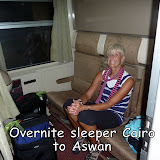 |
| Training to Aswan |
Beginning in Aswan we checked out the High Dam, the Nubian areas, sailed a felluca [small sailboat], and then joined a 3 night cruise heading north, down the Nile to Luxor. It was a boat holding about 60 people and we were thrown together with another two honeymooning couples as Chris has previously described. And we are all now best friends and will never see each other again. Getting glimpses of life along the Nile and thinking about how this river is so crucial to all of the people of Egypt was enlightening to say the least. We stopped along the way to visit temples and tombs [see below] but one stop at night was our favorite. At Esna, we had a special Egyptian night and then there were dances and stuff. We opted out of the dances and were, I think the only people to get off the boat and head into the village. So cool. We bought spices, played with the kids, met a family and had tea in their home. Special.
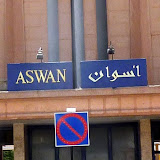 |
| Floating the Nile river |
And now the temples and hieroglyphics along the Nile including the Luxor Valley of the Kings and all of that. I could have included 2000+ pics and tried to do my best interpretation of the glyphs for you but I'm letting you off easy.
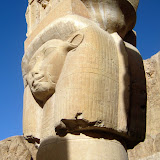 |
| Hieroglyphs and temples |
Taking a cruise down the Nile sounds Luxorious, and it is, but there is too much to learn and when it's 112 degrees, one needs to cool off. We did. After our cruise, we flew over to the Sinai peninsula and headed up the east coast of Sinai to Dahab, on the Red Sea. A bit of kick-back time and diving. I have previously described some dives so here are the pics for Dahab.
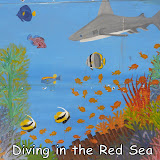 |
| Dahab |
Jordan pictures will be coming soon!
Cheers!
CHRISBLURB--EGYPT
I Met the Best Driver in Egypt
In Egypt there are three important things a professional driver must possess: Good brakes, Good horn, and Good luck. If one of these is bad, it is Good-bye. That is what our driver told us on the way to the pyramids. He also reassured us that he is the best driver in Egypt because he averages only two accidents per day. Then he smiled and added, “And not to worry today, because I already had my crashes before I picked you up.” Yes, a competent driver is most important. Moreover, we felt lucky to even survive crossing the street on the way to hiring this driver; the language of traffic here is unscripted, like wrapping I-5 in knots and trying to gallop across it. Major city streets converge from five or six directions, and traffic moves extremely fast. We are passed by truckloads of impertinent camels, legs folded into a truckbed, craning their necks at whatever whizzes past. Scruffy white vans packed full of Egyptians commute between souks and steaming labyrinths, doors ajar, able to be mounted if a pedestrian can leap aboard while roaring down the roadway with the tout yelling out the destination. Sidewalks team with motos, trash cans, barricades for whatever purpose, stands of water, brass dishes, perfumes and brooms, so that most people choose to march along in the roadways alongside the screaming traffic.
We stop for petrol while touring the three major pyramid sites in Cairo. Our best driver in Egypt pulls into the station and backs up to the pump, chatting in Arabic with our tour guide the whole time. He leaves the motor running as a guy with a cigarette hanging from his mouth sprouting 3 inches of ash on the end comes over and opens the gas tank. The driver cracks the window of our air conditioned car and mumbles something, and then closes the window. After a few minutes of filling, he rolls down the window and places a wad of cash in the attendant’s hand. We move on to the next site, without even a break in the conversation. Petrol is about $1.00 a gallon here; our guide Mags tells us that Egypt has good oil and natural gas resources.
Speaking of Resources
We ask Mags, our guide, if he is worried about other countries tapping into the Nile, as we can see how within one inch, the valley changes from verdant---where date palms and agricultural fields line the canal-veined floor of Cairo outlands---to hard-packed desert. Irrigation ceases within an instant. With the 104 degree temperature here, it seems impossible to imagine what would happen without the proximity of the Nile. Mags comments, “Well, if another country tries to block the Nile, we have a very good Air Force.” Okay. That settles it then.
Plastic bags and bottles blow everywhere, littering the landscape. In Cairo there seems minimal effort to recycle, whereas in China, Thailand, and Cambodia, we saw concerted efforts to gather all plastic bottles (though not so much the plastic bags which seem a problem there as well) and cans. Along the roadside throughout those countries, huge areas of redistribution are evident, with designated areas stacked high with plastic bottles headed for recycling. We ask Mags about it, and he says that for the most part, people don’t recycle in Egypt. I notice some plastic bottles being burnt in piles of rubbish along the road. There is a huge amount of smog…I think it is smog…something like that…here in Cairo. Yesterday the pyramids were hardly visible from across the roadway, but we are told that in reality, it was a dust storm. Surprisingly, the Great Pyramids are situated immediately adjacent to a road where the traffic rips along at 50-60 miles per hour. Photos commonly viewed in tourist brochures are taken from a camera angle that blocks out the roads. I wonder about damage to the pyramids from the exhaust. In contrast to efforts we have seen to clean the air near the Taj Mahal in India or in Beijing, I do not see an awareness about that here. Maybe I can’t read the signs or campaign literature. With such an amazing history of artifacts dating 2000 BC and onward, it would seem vital to protect these precious monuments. In contrast, the ruins we will view at Luxor and other upper Nile areas are less prone to damage by traffic since they are in less populated areas.
Finding our Way
Tourists are such helpless souls. We need special buses and herds of other fellow tourists to clump us into sites where ordinary people proceed with daily life. We need special air-conditioned taxis while the local citizens bicycle, walk, or ride in donkey carts at our side. Locals pile into roadside vans that only take off when a loadful of people has boarded. The vans are unmarked, with touts yelling out the destinations as they hang out the severed doorways. It looks efficient if one can figure out where they are going. Don and I take many taxis while in Cairo; we are fortunate to be able to afford it. The usual ride is about $5 US. A common problem here is that many drivers can hardly speak English (understandably), but even more difficult, if we show them something on a map, they do not seem able to read a map or to recognize a site written in either Arabic or English. So then, another citizen (usually a competing English-speaking driver) comes over to interpret, and then this new person wants us to use his cab, meanwhile the original driver finally figures out where we are going and pushes the interpreter away. Normally, it is all worked out with smiles resulting, but in the hot weather and on dusty roadsides, it can get very loud and uncomfortable. This problem was avoided in China, where our hotels provided us with a small card listing about 15 major tourist sites in both English and Chinese, plus directions in Chinese to show to any driver. In Thailand, the ferries have created an ingenious way to sort and disperse the tourists: they put colored and labeled sticky notes on our shirts (similar to those pinned onto kindergarten children) denoting at which stop a traveler should disembark. It is impossible to understand the intercom announcements, so at the stops, not only do they announce it, but someone patrols the decks and checks shirt labels to herd the passengers off at the different docks: A very efficient method, except for Don who is so sweaty that the sticky label came off and we lost it somewhere. We finally put it on his sandal. They shooed him off along with me, no doubt anxious to get rid of another pathetic and lost wanderer. Somehow we tourists find our way.
Walk Like an Egyptian
This morning about 7 am we strolled around the Giza area to scout a breakfast site that would allow us to gaze up at the pyramids as we ate. On our way, we passed a huge corner of white uniformed police. They are everywhere here, and I mean at least two per block, two per corner, slumped in the heat along the ruins, at hotel entrances, and in the Islamic quarters with “tourist police” armbands, on camels patrolling the ruins, even checking our best driver in Egypt to see if he is wearing his seatbelt. (He hurriedly puts it on when approaching roundabouts). Today, as we walked, we strolled through a huge encampment of the white uniformed guys. I forgot because it was early in the morning, and had eye contact with one of them ---a no-no: Eye contact right down the barrel of a rifle pointed at my scull, with nonsmiling eyes behind. Then we noticed spiky things set in the streets, black and white barricades, and that all other pedestrians had moved outside these barriers while here we were right in the midst of the no-walk zone. A slight shudder, but we just continued on as though it were perfectly normal to have gun barrels shadowing us on the way to breakfast. I glanced to the side and noticed a post office there. Maybe they have to guard the post office especially well. The Egyptians who had discreetly moved out of the rifle zone must have thought we were crazy to walk where we did. But we did. Getting around Cairo is serious business. You learn to walk like an Egyptian.
It was a shock the first time we entered our Cairo hotel. It was about 7 am as our airport taxi pulled up to a checkpoint at the hotel entrance. Five steel columns erupted in front of us as well as the usual railroad crossing type barrier. A man with the meanest Rin Tin Tin you have ever seen came out of a guardhouse, and also three or four other big guys, some in the white uniforms. The dog and trainer walked all around the vehicle as the driver shut off the motor and opened the trunk. They looked inside our car as Don smiled and waved at them. They did not wave back nor did they smile. They asked the driver something and acted like they didn’t believe him, then they dropped the steel cylinders, raised the barrier, and we proceeded to the hotel entrance to check in. The usual bellboy routine ensued, but upon entering the front door, we immediately had to put our handbags on a security x-ray belt and walk through a scanner which we both set off. Several people eyed us severely, then handed us our things whereupon we walked over to proceed with a pleasant and courteous check-in. At every hotel I have entered in Cairo (major tourist hotels) there are devices and dogs such as this. No one questions it. After three days now we are hardened; we just throw our stuff onto the belt and proceed. When the beepers sound, there is nothing more done except perhaps a second glance at us. At many museums, there are also security and scanning devices. Many eyes are upon us wherever we go, as many eyes are upon all people here. Maybe that is why travel in Egypt is reputed to be so safe…day or night. There are no warnings of purse snatchings or backpack slicing, such as we had in Cambodia. Too many eyes.
Just two days ago Egypt opened a formerly closed entrance to the Gaza Strip as a result of the Israeli assault on the protest flotilla. It has been fascinating to see the editorials and news about this event from this side of the globe. Our guide, when we questioned him about politics here, shrugged his shoulders and said that politics are corrupt. It is a given.
When asked about social courting and marriage, our guide reports that young people are marrying later here (now even in their 30’s) whereas before they married by age 21 or 22. He believes this is because life is very expensive. The same sentiment was echoed to us by young men we spoke with in Cambodia and by our guides in China, many of whom were in their late twenties or early thirties, and all unmarried. Their tolerance of corrupt politics, damaged environment, stricter security, and more expensive lifestyles coincide with an attitude of resignation, yet also with intense desire to know and navigate the larger world. I realize that in our travels, Don and I are associating with more highly-educated young adults, people who can communicate with us at a higher level, so I want to hear their views and comments about the world. Sometimes I wonder why they are so accepting of their country’s situation, but behind their seeming passivity, I see resolve, a steely desire to make life better. I also see patience, and an intent to understand others. They are interested to see pictures of where we live: the small map I carry that shows the USA, Canada, Mexico, (the two Washingtons and where NYC and California are which everyone in the world seems to understand), photos of our family and Olympia and Mount Rainier. (It is so green! they say.) These future leaders of their nations will move their countries forward. They are watching and waiting and learning as they prepare.
Niling Away the Time…
Tonight we leave for 3 days of boat tour up or down the Nile. I am never sure which direction, since it runs upside down. Or I am on my head. Or, let’s face it; I have no sense of direction. That is why, as I said, I am a helpless tourist. Somehow, we will find the train station tonight and board an overnight train to Aswan. We are now at the halfway point of our journey. It has been fun receiving notes and comments about this trip from our friends One person just e-mailed us that we are far more interesting people gone.
Of course, after an interesting night in an Egyptian sleeper car, we did arrive at Aswan to meet our cruise ship, The Sonesta Nile Goddess. This is our first cruise ever, scheduled for three nights. I am skeptical of cruises, but people say this is a good way to see the Upper Nile, so we will try it out. After the experience, I will say that I agree. The temperatures in Luxor are 110 degrees F, and having a lovely cabin with lots of towel changes and showers and cool-sprayed decks is glorious. There were only about 70 pasengers total, from every flavor of the world: Italy, Portugal, Spain, Egypt, Africa, Australia, and one other American family. Another fabulous advantage to cruising was having an Egyptologist (Harni, 29 years of age), who stayed with 6 of us English-speakers for all three days. Harni pulled our previous tour information together and provided a fabulous course in history and culture, as well as answering any kind of question we had about contemporary Egyptian life. He is very proud of his Egyptian heritage, yet has not yet been able to get a visa to travel anywhere else in the world, though highly educated. (The same is true of Mags, our guide in Cairo whose sister lives in Chicago; he has been denied a visa to visit her and her children.) Harni, from Luxor, hopes to venture to Turkey next year and had all kinds of questions for Don and me once he found out about our past travels there. He sheepishly confessed that he would take a canned tour of Turkey, because he has no experience…this from someone who organizes and herds thousands of tourists each year in his own country!
The other delightful experience on the cruise ship was learning to know our tablemates, two honeymooning couples who had been married less than four days (compared to our almost 40 years!). Ashley and Nerisha came from Johannesburg, SOUTH AFRICA! They had just celebrated a Hindu wedding, of Indian heritage, and Nerisha’s delicate feet, arms and hands bore intricate henna designs. The other captivating couple from our table currently lives in Nairobi, Kenya: Tim originally hails from Australia and his new wife, Olena, from the Ukraine. We all had differing accents, and it was fascinating as we compared jargon, lives, and politics. Again, Don and I are even older than these young couples’ parents, but we tried to keep pace and had a splendid time at every meal and tour. Also joining us on some of our tour days were a Brazilian woman and her Belgian husband who own homes in both Florida and Brazil. All of these travelers epitomized a deep respect for other cultures and openness to the greater world. I learned from them each minute.
So what do I say about the Nile tour? It was fantastic! We had languid views of tiny villages, stops to venture into dusty towns where Don and I were invited into an Egyptian home and held their new 20-day old baby and met all the extended family, had coffee in a spice market, and of course many-too-many opportunities to escape aggressive sales attacks of the bazaar vendors.
Red Sea Above and Below
Currently we find ourselves in Dahab, Egypt, where we just spent two days diving in the Red Sea and experienced the famous Blue Hole and Canyon dive. There are so many more dives to do, but for me, gearing up and slogging to the rocky shore encumbered with weight belts, wet suit, and tank is almost harder than the dives! Don will describe our dives in more detail. How addicting it is, and I have never seen bluer water, clearer skies, and more mesmerizing conditions, all backed by jeep and camel drivers wearing robes and headdresses. The dirt road drives to the dive sites are always an adventure, with goats, children, and camels loping across our pathway to the sea. In some ways, the landscape here looks like Wenatchee: dirt foothills within spitting distance and no apple orchards, but instead a blue sea lapping at the crusty brown land. The weather has cooled from the heat of Aswan’s 112 degrees to a mild 104 degrees, sweetened by desert winds. Our hotel has a Bedouin tent on the perimeter, and last night three robed men invited us to sit by their coal-lit fire for tea. They served us an aromatic herb concoction, good for the stomach as they showed us by rubbing their bellies. After about five “welcome friends” and “America our friend” and “okay you like?” and the appropriate time cooling and complimenting over our tea, we eased ourselves up off the colorful carpets and cushions and tottered on our way. Hot winds and whisking date palms beckoned us towards welcome sleep, as stars and gently sloshing waves escorted us back to our hotel room. Salome. Awww, ahhh... It is glorious.
_____________________________________________________________________________________________________
EGYPT--a dv Vlog
Talk Like an Egyptian
Talk Like an Egyptian
Donny Appleseed
Wow! Waking up in Cairo. What an adventure! What a city! Chris and I have been busy doing all of the typical touristy stuff plus attempting a few more off beat things. Too much to do, too little time.
At the end of one day, I asked Mags, as our guide called himself, if he had a recommendation for a good, typical Egyptian food restaurant. He recommended "Appleseed" which was a few minutes from our hotel. Then we asked our Concierge how to walk to the Appleseed restaurant and without batting an eye, she gave us very good directions. Five minutes later we were pacing up and down streets and asking people where the Appleseed restaurant was and each set of directions ended up at the same place but there was no sign displaying Appleseed! Since there was one particular place that seemed to have lots of activity we walked over to what was the Appleseed restaurant--how funny to discover that it was called Abou el Sid! I was so impressed with my Arabic.
At the end of one day, I asked Mags, as our guide called himself, if he had a recommendation for a good, typical Egyptian food restaurant. He recommended "Appleseed" which was a few minutes from our hotel. Then we asked our Concierge how to walk to the Appleseed restaurant and without batting an eye, she gave us very good directions. Five minutes later we were pacing up and down streets and asking people where the Appleseed restaurant was and each set of directions ended up at the same place but there was no sign displaying Appleseed! Since there was one particular place that seemed to have lots of activity we walked over to what was the Appleseed restaurant--how funny to discover that it was called Abou el Sid! I was so impressed with my Arabic.
Anti-Nile:
In many places outside the US the gastro-intestinal challenges can be, well, challenging. What is safe to eat and drink is always potentially problematic. You just don't want to get sick. But no matter what, it can happen. I won't go into details about our experiences other than mostly, not so bad. We tend to not necessarily follow the conventional wisdom in international dining [see previous scorpion and cricket dining] and sometimes with regret. Here's another anecdote:
Before going on our Nile cruise. our guide in Cairo said to be careful of the water and food even on the cruise ships. He recommended that we go to a pharmacy and purchase, Anti-Nile. Hmmm. Made sense. If the problem happened from the Nile, Anti-Nile should work, right? I found a pharmacy, around the corner and a couple blocks away where I could have probably purchased anything from narcotics to Viagra. I asked if they had Anti-Nile. Easily understood in my best Arabic, the pharmacist produced, AntiNal. Okay. If I were a Brit, I guess it would have made sense. AntiNal is actually an antibiotic which probably would rid one's gut of any bad and even good bugs. But on the cruise, so far, so good, more-or-less. I'm saving my Anti-Nile for a more potentially formidable GI foe!
****************************************************************
****************************************************************
What a dive!
Our VolkVenture has always had the potential for us to SCUBA dive in some of the BEST places in the world. I have mentioned that we did two dives in Thailand that were like Avatar experiences. Amazing!
But then, we headed to Egypt and the Red Sea. We're so glad we followed Tyson's advice and came to the laid back town of Dahab on the East coast of the Sinai Peninsula. We flew from Luxor, after our cruise down the Nile to Cairo and then Sharm El Sheikh at the tip of Sinai. From the air, Sharm looked like a huge expanse of only big resorts. From there we headed North for a couple hours to our hotel called Dahab Paradise, where they welcome you by saying, “Welcome to Paradise!” And it is. It's not a big 5 star place; just a small out of the way super cool place to be.
As to our dives:
Those of you who do not snorkel or dive may want to move on to a favorite YouTube video or the current World Cup match and that's okay.
Our first two dives were south of Dahab in an area called Moray Garden and Three Pools. All of our dives here are shore dives with difficult entry walking on rocks, not sandy beaches. The booties help and once in the water, all is good. The first two dives were okay, regular kind of scenery, fish, incredible clarity but not as colorful as our Thai dives [says the colorblind diver.] Enjoyable, [went to 20 m or 60+ ft. on both dives], but not anything as spectacular compared with Thailand. Our second two dives the next day we took as "Adventure Dives" which count as 2 of 5 for our advanced certification--had to study and take exams for the Deep and the Drift dives. We first did The Canyon. OMG! We dove down along a deep wall that was spectacular. I saw a cool brown octopus with a head about 2' in diameter. We then dove further into this deep ravine to 30 m [100 ft.] where our instructor tested us with a number thing to assess nitrogen narcosis [a problem in diving related to air compression which causes disorientation, etc.—the reverse side of that is ascending too quickly causing “the bends”]. Chris was able to do the numbers faster at 100 ft below than on land! Who knew?
Our next dive was the famous Blue Hole. We started at the Blue Bells where we entered through a crack in the coral toward an all blue background. At about 8-9 meters we dove straight down, head first through this narrow chimney [Blue Bells stands for the noise of divers' tanks hitting the rocks as they descend through this narrow chimney.] So it is a straight plunge, head first for 20 m [60+ ft.] then you pivot and exit under an arch back into the full blue sea. Such an amazing thing to do. I did it real fast not adjusting my ears too well, apparently, and had excruciating rt. ear pain but it would not slow me down and after exiting under the arch, I ascended for awhile to work on my ears. My rt. ear is still messed up.
From there at 30 m., we followed a wall which was a half kind of cave on our rt--fantastic with an 800 m full blue bottomless sea to the left. We eased our way up and then over a coral arch into the Blue Hole. As you glide over the arch and into this hole, all is brilliant royal blue in every direction. It's like a free fall. You are literally floating, suspended in blue and soon it's very easy to become disoriented but it's is so amazingly exhilarating. Without checking our depth gauges and where fellow divers are it would be easy to just keep descending quietly as all of your air compresses and goes away. At the bottom of the Blue Hole, 130 m [400+ ft] there is an exit under an arch out into the deeper blue and a chance to ascend. Many divers have tried to do this dive to the bottom of the Blue Hole and out. Many have failed. Nitrogen narcosis, disorientation and running out of air. It's a bad idea to try. Walking to the entry at the Blue Bells where we started our dive, there are memorials to some who have tried this dive and failed. Dave's memorial has his date of his failed dive, a little diver picture and the words, "Have a fun dive!"
Fortunately, we did. So sorry, Dave. I hope it was good for you while it lasted.
Our next dive was the famous Blue Hole. We started at the Blue Bells where we entered through a crack in the coral toward an all blue background. At about 8-9 meters we dove straight down, head first through this narrow chimney [Blue Bells stands for the noise of divers' tanks hitting the rocks as they descend through this narrow chimney.] So it is a straight plunge, head first for 20 m [60+ ft.] then you pivot and exit under an arch back into the full blue sea. Such an amazing thing to do. I did it real fast not adjusting my ears too well, apparently, and had excruciating rt. ear pain but it would not slow me down and after exiting under the arch, I ascended for awhile to work on my ears. My rt. ear is still messed up.
From there at 30 m., we followed a wall which was a half kind of cave on our rt--fantastic with an 800 m full blue bottomless sea to the left. We eased our way up and then over a coral arch into the Blue Hole. As you glide over the arch and into this hole, all is brilliant royal blue in every direction. It's like a free fall. You are literally floating, suspended in blue and soon it's very easy to become disoriented but it's is so amazingly exhilarating. Without checking our depth gauges and where fellow divers are it would be easy to just keep descending quietly as all of your air compresses and goes away. At the bottom of the Blue Hole, 130 m [400+ ft] there is an exit under an arch out into the deeper blue and a chance to ascend. Many divers have tried to do this dive to the bottom of the Blue Hole and out. Many have failed. Nitrogen narcosis, disorientation and running out of air. It's a bad idea to try. Walking to the entry at the Blue Bells where we started our dive, there are memorials to some who have tried this dive and failed. Dave's memorial has his date of his failed dive, a little diver picture and the words, "Have a fun dive!"
Fortunately, we did. So sorry, Dave. I hope it was good for you while it lasted.
There are no pictures here but in our minds' memory banks. I wish we could share. Very precious. Just go see Avatar again.
